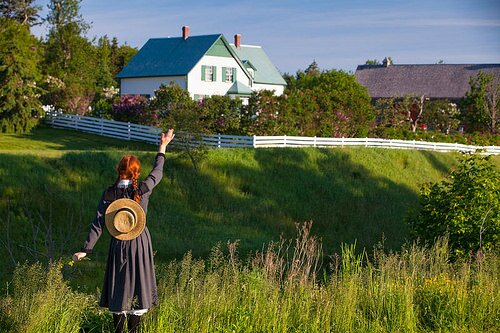After the sometimes unbearable lightness of Stephen Leacock and his Sunshine Sketches, it is time once again to return to the darkness. We’ll ease into it this time, however, with a quick study of Lucy Maud Montgomery, the creator of Anne of Green Gables, a trailblazing Canadian writer, and a far more interesting personality.
Montgomery’s young heroines are precocious, sharp-tongued, deeply sensitive, not conventionally attractive, prone to tragically losing relatives and friends, and carry within them dreams of literary superstardom and an unbreakable core of innocence. The red-headed, pigtailed Anne is the best-known, and someone needs to do a compare and contrast between her and Little Orphan Annie of comic strip fame. But Emily of New Moon and her quest to develop her literary skills – her climb up the “Alpine Path“- will touch a chord with anyone who’s gone through the cycle of having to put their written work back together after having it pulled apart by an editor.
Montgomery did much to popularize a region of Canada I haven’t talked about much: the eastern Maritime provinces, and specifically her birthplace, the tiny Prince Edward Island. We will give each of the four Maritime provinces their due, but the P.E.I. depicted in Mongomery’s novels was, and is, so gorgeously pristine that it drove annual tourist migrations from all over the world. Official government websites promote tours where Anne’s world is preserved in a sort of historical amber, but Montgomery’s original sells it better:
“Anne reveled in the drive to the hall, slipping along over the satin-smooth roads with the snow crisping under the runners. There was a magnificent sunset, and the snowy hills and deep blue water of the St. Lawrence Gulf seemed to rim in the splendor like a huge bowl or pearl and sapphire brimmed with wine and fire. Tinkles of sleigh bells and distant laughter, that seemed like the mirth of wood elves, came from every quarter.”
Or:
“Below was a little valleyand beyond a long, gently-rising slope with snug farmsteads scattered along it. From one to another the child’s eyes dared, eager and wistful. At last they lingered on one away to the left, far back from the road, dimly white with blossoming trees in the twilight of the surrounding woods. Over it, in the stainless southwest sky, a great crystal-white start was shining like a lamp of guidance and promise.”
Gabled cottages, whispering woods, untouched blue skies, stunning sunsets, and the soft roar of the sea: by far, the most interesting character in Montgomery’s work is nature itself. Montgomery was not the first Canadian writer to do this – that honour belongs to Catherine Parr Traill– but while Traill used paper-thin characters as a way to showcase Canada’s natural beauty, Montgomery sublimated her desires and frustrations into her work, and in doing so inaugurated her own Canadian literary tradition. She developed the trope of the artist who tries desperately to keep up the appearance of normalcy and tranquility in her work as the struggles and traumas of her life bleed onto the page, the screen or into the music.
For more remarkable than any of Montgomery’s considerable literary achievements were the unhappy circumstances of her life: a long and loveless marriage to a man clearly less impressive than her, draining legal battles with greedy publishers, guilt over her full-throated support of World War I, illness, depression, and finally, suicide through overdose.
And, sadly, but understandably, Montgomery’s art reflected her life, in the succession of unmarried or widowed aunts that pry into or restrict the lives of her heroines; in the parade of damaged, inadequate and duplicitous men such as Emily’s fiancée Dean “Jarback” Priest, a Canadian version of Mr. Darcy, or Anne’s Uncle Matthew, who almost hides entirely from the world; and in the mundane tragedies that keep her young women bound to the island-bank failures, Spanish flu, heartbreak, and most critically, a loss of the ability to write.
Depending on your viewpoint, Montgomery’s sacrifice, intended to preserve the magic of her enchanted isle, is tragic, noble, or both. Anime adaptations of Anne, Finnish web dramatizations, and the Green Gables Fables Youtube channel abound, but the true darkness of Canadian life is only present in Montgomery’s work if you seek it out – as the new Netflix series Anne With An E does, though this newest version verges on the Woke Reboot.
But next, we’ll finally explore a Canadian writer who embraced the turmoil of his life and circumstances and whose art was defined by it. I speak of the literary titan of Old Jewish Montreal, the dark wizard of St. Urbain Street, Mordechai Richler.
*****
Part 1 on Heroes: ‘Scott Pilgrim Vs The World’ Vs Terrance Denby and ‘Sidequest’
Part 2 on “Humour”: The Libertarian Fantasy of ‘Letterkenny’
Part 3 on Graphic Novel Nihilism: The Harsh Truths of ‘Essex County’
Part 4 on Spawn and Wolverine: Banished From The Promised Land: A Tale of Two Canadian Anti-Heroes
Part 5 on Science Fiction Dystopias: Inside Quebec’s – and Canada’s – Replicant Culture
Part 6 on Animation: The Garrison Mentality: More Than Meets The Eye
Part 7 on Pop Music: How To Build A Successful Canadian Musical Act
Photo by TourismPEI 



Comments
Leave a Reply